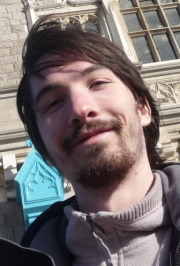In the same section
Teacher at Haute Ecole Léonard de Vinci

-
PhD Thesis
-
Deep Learning in digital pathology
Whole-slide imaging in histology produces a large amount of raw image data. Many different computer vision tasks may be performed on this data: segmentation of structures of interest (nuclei, glands...), detection of events (mitosis...), classification of tissues (cancer grading...). The objects of interests in digital pathology tend to be hard to describe using traditional image processing features. This makes digital pathology a prime candidate for Deep Learning methods.
-
Master Thesis (in french)
-
Extraction de paramètres morphologiques de neurones à partir d'images obtenues par microscopie confocale à balayage laser
Avec : Olivier Debeir, David Gall.
Dans le cadre de la recherche en neurophysiologie, il est nécessaire de pouvoir extraire des informations quantitatives sur la morphologie de différentes populations de neurones. Ces mesures permettent de déterminer l'influence de certaines protéines sur le développement des neurones, et donc d'atteindre une meilleure compréhension de phénomènes tels que les maladies dégénératives (Parkinson, Alzheimer...) ou le vieillissement. Les images sont acquises à l'aide d'un microscope confocal à balayage laser : on dispose alors d'une série d'images en coupe du neurone, ce qui permet d'en effectuer une reconstruction tri-dimensionnelle. Les algorithmes développés dans le cadre de cette recherche concernent principalement l'extraction du graphe caractéristique de la ramification des dendrites dans le neurone, ainsi que sa segmentation précise pour pouvoir effectuer dessus des mesures correctes. Ce projet de recherche est réalisé en collaboration avec le Laboratoire de Neurophysiologie de la faculté de Médecine.
-
Teaching
-
- 2024-2025 : STAT-H-400 Multivariate data analysis
-
Publications
-
See more on Difusion
Last conference papers
Communications publiées lors de congrès ou colloques nationaux et internationaux
A paraître
Ranking the scores of algorithms with confidence
Foucart, A., Elskens, A., & Decaestecker, C. (2025). Ranking the scores of algorithms with confidence. ESANN 2025 European Symposium on Artificial Neural Networks, Computational Intelligence and Machine Learning(23-25 April 2025: Bruges, Belgium)
https://dipot.ulb.ac.be/dspace/bitstream/2013/386897/3/FOUCART25_CIRank_ESANN.pdf2024
Finding the best channel for tissue segmentation in whole-slide images
Foucart, A., Elskens, A., Debeir, O., & Decaestecker, C. (2024). Finding the best channel for tissue segmentation in whole-slide images. Proceedings of the 19th International Symposium on Medical Information Processing and Analysis SIPAIM(15-17/11/2023: Mexico City, Mexico) doi:10.1109/SIPAIM56729.2023.10373416In digital pathology, segmentation between tissue and glass slide is a very common pre-processing step in image processing pipelines. It is often presented as relatively trivial, and solved using ad-hoc heuristics that are not always precisely defined nor justified. Most tissue segmentation pipelines start by reducing the color image to a single-channel representation, grayscale being the most common. We show in this study that representations that focus on the colorfulness or entropy offer better separability between tissue and background, and lead to better results in simple thresholding pipelines.
https://dipot.ulb.ac.be/dspace/bitstream/2013/363134/3/SIPAIM23-Foucart-Manuscript.pdfAssessing Local Descriptors for Feature-Based Registration of Whole-Slide Images
Elskens, A., Foucart, A., Zindy, E., Debeir, O., & Decaestecker, C. (2024). Assessing Local Descriptors for Feature-Based Registration of Whole-Slide Images. Proceedings of the 19th International Symposium on Medical Information Processing and Analysis, SIPAIM(15-17/11/2023: Mexico City, Mexico) doi:10.1109/SIPAIM56729.2023.10373514Feature-based registration has become increasingly popular in digital pathology for achieving initial global alignment between image pairs. However, the selection of algorithms used in this approach is often not well-justified. Specifically, the choice of local feature descriptor is rarely, if ever, discussed in the context of digital pathology. The majority of feature-based whole-slide image registration methods rely on the SIFT descriptor. In this study, we demonstrate that the choice of descriptor significantly influences the quality of registration results and that the BRIEF descriptor captures more optimal information for histological image registration.
https://dipot.ulb.ac.be/dspace/bitstream/2013/363969/3/SIPAIM23_Elskens-Manuscript.pdf2021
Processing multi-expert annotations in digital pathology: A study of the Gleason2019 challenge
Foucart, A., Debeir, O., & Decaestecker, C. (2021). Processing multi-expert annotations in digital pathology: A study of the Gleason2019 challenge. Proc. SPIE 12088, 17th International Symposium on Medical Information Processing and Analysis. Vol. 120880X International Symposium on Medical Information Processing and Analysis(17th: Campinas, Brazil). doi:10.1117/12.2604307
https://dipot.ulb.ac.be/dspace/bitstream/2013/353666/3/FOUCART21-Gleason2019.pdf2019
SNOW: Semi-Supervised, NOisy and/or Weak Data for Deep Learning in Digital Pathology
Foucart, A., Debeir, O., & Decaestecker, C. (2019). SNOW: Semi-Supervised, NOisy and/or Weak Data for Deep Learning in Digital Pathology. In 2019 IEEE 16th International Symposium on Biomedical Imaging (ISBI 2019) (pp. 1869-1872) IEEE. doi:10.1109/ISBI.2019.8759545Digital pathology produces a lot of images. For machine learning applications, these images need to be annotated, which can be complex and time consuming. Therefore, outside of a few benchmark datasets, real-world applications often rely on data with scarce or unreliable annotations. Inthis paper, we quantitatively analyze how different types of perturbations influence the results of a typical deep learning algorithm by artificially weakening the annotations of a benchmark biomedical dataset. We use classical machine learning paradigms (semi-supervised, noisy and weak learning) adapted to deep learning to try to counteract those effects, and analyze the effectiveness of these methods in addressing different types of weakness.
https://dipot.ulb.ac.be/dspace/bitstream/2013/286269/3/Paper_ISBI2019_final.pdf2018
Artifact Identification in Digital Pathology from Weak and Noisy Supervision with Deep Residual Networks
Foucart, A., Debeir, O., & Decaestecker, C. (2018). Artifact Identification in Digital Pathology from Weak and Noisy Supervision with Deep Residual Networks. The 4th International Conference on Cloud Computing Technologies and Application (CloudTech'18)(Novembre 26-28, 2018: Brussels, Belgium) doi:10.1109/CloudTech.2018.8713350
https://dipot.ulb.ac.be/dspace/bitstream/2013/286814/3/FOUCART18-ArtifactIdentification.pdf2012
Unsupervised vehicle detection in traffic scene using distributed one class classifiers
Foucart, A., & Debeir, O. (2012). Unsupervised vehicle detection in traffic scene using distributed one class classifiers. International Symposium on signal, Image, Video and Communications (6 June 2012)
https://dipot.ulb.ac.be/dspace/bitstream/2013/146728/1/isivc_conf.pdf
